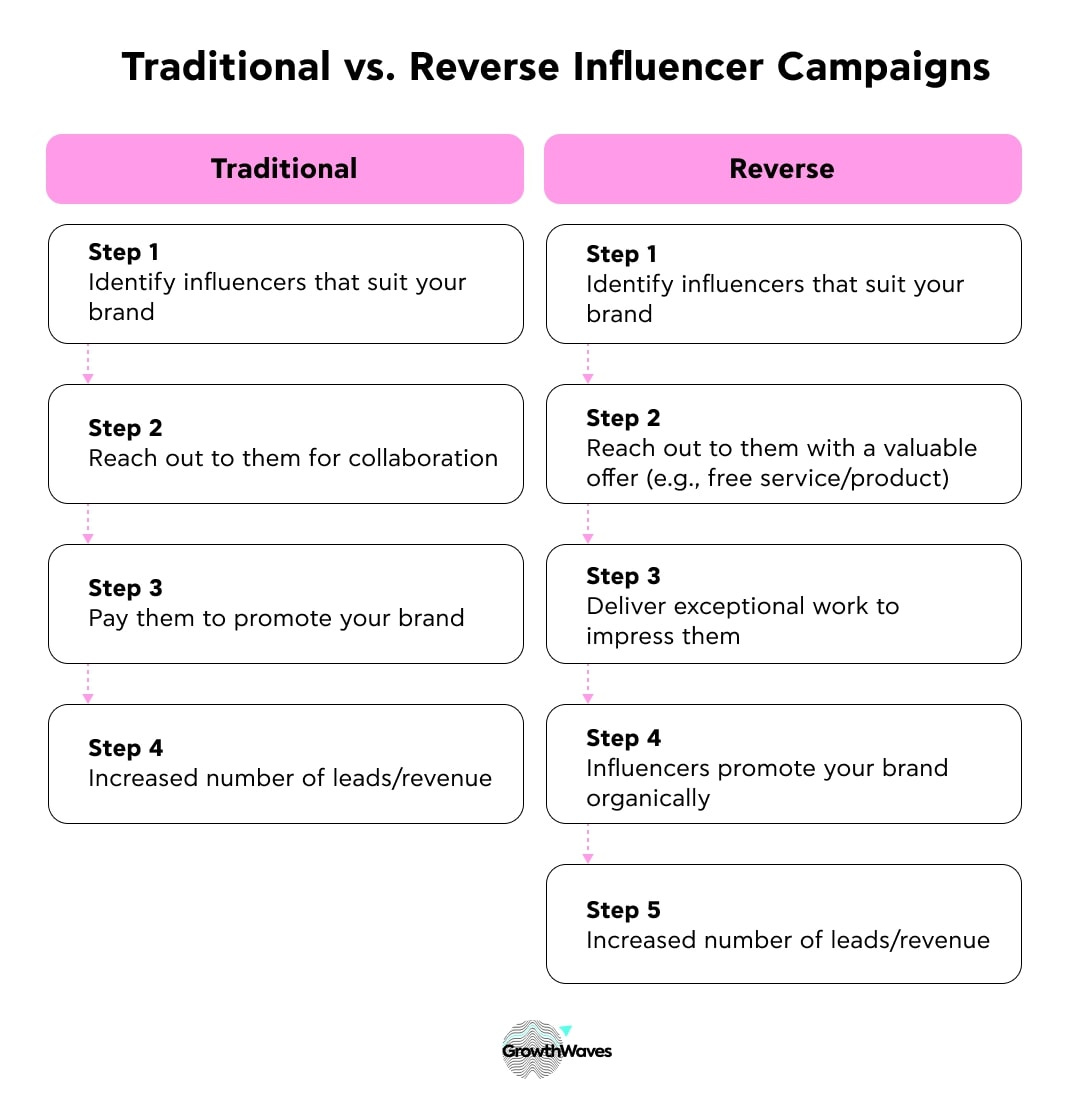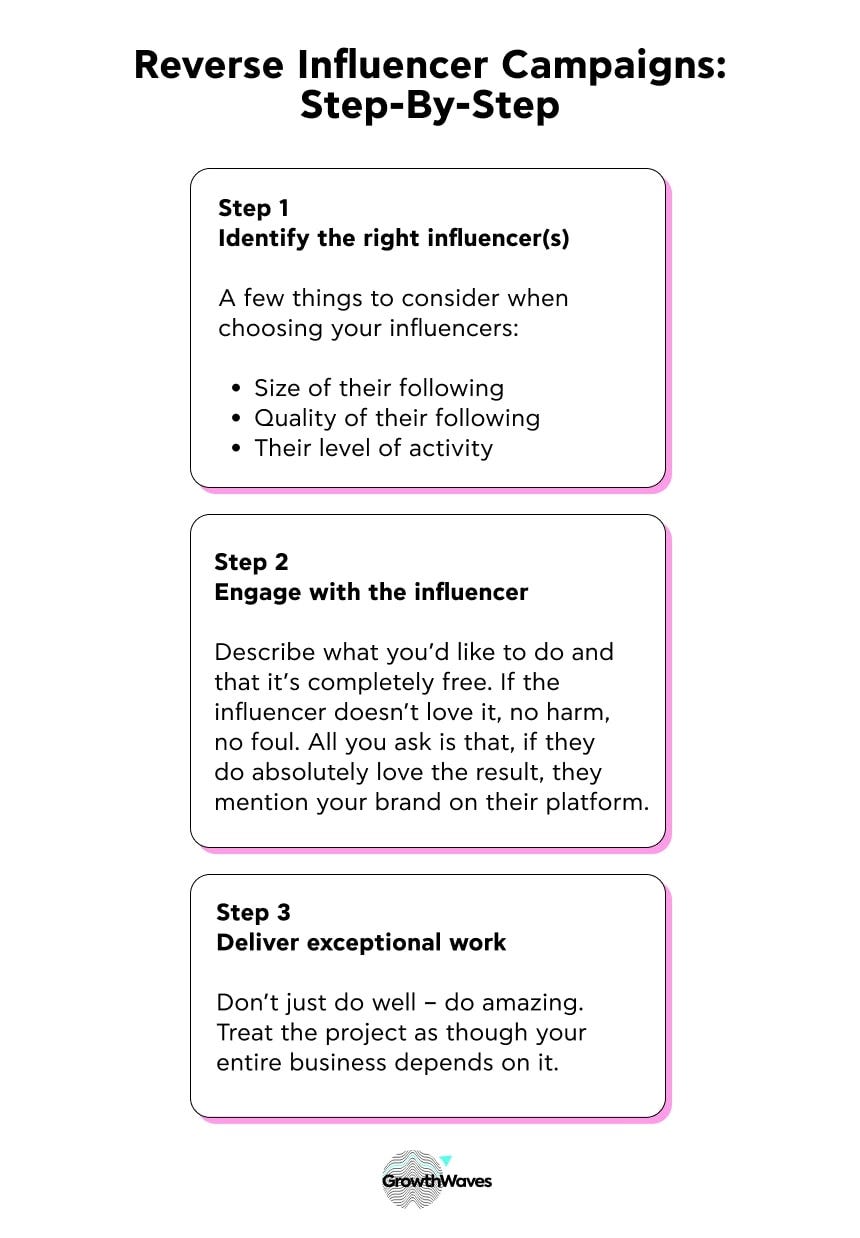Reverse influencer campaigns
The unexpected influencer strategy behind $1M in revenue
👋 Hey, I’m George Chasiotis. Welcome to GrowthWaves, your weekly dose of B2B growth insights—featuring powerful case studies, emerging trends, and unconventional strategies you won’t find anywhere else.
A traditional influencer marketing campaign goes roughly like this:
Identify influencers that suit your brand > Reach out to them for collaboration > Pay them to promote your brand > Increase the number of leads/revenue.
It’s a well-known playbook that works, as long as you know what you’re doing and execute the campaign well.
But what if we switch it up a bit?
What if, instead of investing money in an influencer campaign, you invest your time and expertise?
Here’s how Eli Rubel and his team at NoBoringDesign used what I dubbed reverse influencer campaigns to grow their business.
Key Findings (TL;DR)
A reverse influencer campaign consists of you delivering outstanding work to your influencer of choice (free of charge) in exchange for them mentioning your brand to their audience.
Eli Rubel of NoBoringDesign successfully executed two such campaigns to the tune of $1 million in attributable revenue.
The playbook for reverse influencer marketing is actually relatively simple: find the right influencer, engage with them, deliver exceptional value, get mentioned. (Of course, this is easier said than done.)
Whatever you do, do not, by any means, ask for a specific number of posts or mentions, micromanage the content the influencer wants to put out about your brand, or be pushy about finally getting the mention after a successful campaign.
Defining reverse influencer campaigns
A reverse influencer campaign is one in which you deliver exceptional value to your influencer of choice and receive social media endorsement in exchange.
Here’s what it would look like:
Identify influencers that suit your brand
Reach out to them with a valuable offer (e.g., free service/product)
Deliver exceptional work to impress them
Influencers promote your brand organically
Increase the number of leads/revenue.
In essence, you aim to impress the influencer enough that they willingly share their experience with their (preferably) large and engaged audience.
This exposure should generate high-quality inbound leads for your business, with the same caveat as above—as long as you know what you’re doing and execute the campaign well.
Let’s take a closer look at how NoBoringDesign did it.
NoBoringDesign’s success
Eli Rubel, the CEO at NoBoringDesign had a stroke of genius one random day as he thought of Dave Gerhardt, the founder and CEO of ExitFive:
“I was fantasizing about how dope his business model is one day and got curious enough to hit up his website.”
To Eli’s amazement, the ExitFive website wasn’t very good.
For a design agency such as NoBoringDesign, this represented a unique opportunity. Even more unique in that Eli already had a scheduled appearance on Dave Gerhardt’s podcast.
Now, you might think that a reputable design agency pitching an idea of redesigning your website for free is an offer one couldn’t refuse, but Dave did.
“And Dave was like, “Nah dude that sounds like a distraction, it’s good enough. But maybe you can help us out with a mascot?”
While Eli’s team did design an ExitFive mascot, they also went ahead with the website redesign anyway.
The result?
Head on over to Eli’s LinkedIn post to watch the video of Dave’s live reaction to the redesign. (Spoiler alert: He was over the moon.)
How it continued
After a successful campaign with ExitFive, NoBoringDesign seized the momentum with the next influencer: Adam Robinson of RB2B and Retention.com.
While the outcome of this project has yet to be announced by either Eli or Adam, Adam already mentioned in a LinkedIn post that it’s related to creating a new brand identity and that he would absolutely recommend NoBoringDesign as the go-to design agency.
As for the benefits to Eli’s company?
$2.62M (no, that is not a typo) in their pipeline
$1M (also not a typo) in directly attributable revenue
From only two campaigns.
I’d say that is nothing short of impressive.
Let’s get into the step-by-step on how to go about reverse influencer marketing.
Step-by-step playbook
Step 1: Identify the right influencer(s)
This step is not that different from the first step in a regular influencer marketing campaign. After all, you are looking for influencers with the type of audience who would be interested in what you have to offer.
Here are a few things to consider when choosing your influencers:
Size of their following: Obviously, the bigger, the better.
Eli even offers useful follower count benchmarks for B2B creators on different platforms:
YouTube: 5K
X (Twitter): 30K
LinkedIn: 30K
Quality of their following: What percentage of the audience consists of your ICP? Are they active and engaged?
Level of activity: Eli recommends influencers who post daily, but this shouldn’t be the deciding factor if the influencer perfectly aligns with other criteria. A consistent posting frequency is what you’re looking for, whatever it may be.
Step 2: Engage with the influencer
A cold message is always an option, and in such a case, your best approach would be honesty.
Describe what you’d like to do and that it’s completely free. If the influencer doesn’t love the result, no harm, no foul. All you ask is that, if they do absolutely love it, they mention your brand on their platform.
But as we know, cold messaging rarely gets a bite. It might, of course, but chances are slim.
You’re much better off developing a relationship with the influencer. It doesn’t have to be anything too deep – just try interacting with their content before messaging them. Drop likes and thoughtful comments, and engage in conversation to get on their radar. Eli already had a well-developed personal brand on LinkedIn and pre-existing relationships with his influencers of choice.
Step 3: Deliver exceptional work
It should go without saying that you need to go above and beyond.
Don’t just do well – do amazing. Treat the project as though your entire business depends on it.
After all, the only way to earn that mention – the mention that will arguably bring in tens or hundreds of thousands of dollars of revenue (if not more) – is to genuinely wow the influencer.
Bonus: What not to do
Here are the three crucial things to avoid in a reverse influencer campaign:
Asking for a specific number of posts: This will make the partnership feel forced and transactional. You want to preserve the authenticity.
Micromanaging the content they share: Trust that the influencer knows their audience best. Allow them to communicate their experience in their own voice.
Being pushy about the timeline of the promotion: Give the influencer space to formulate their feedback and endorsement. After all, they might have a content calendar to follow. There is no need to keep following up or pressuring them for the promotion.
Conclusion
Will the reverse influencer campaign replace traditional influencer marketing?
Of course not. But there is room for both – going the more expected route of paying the influencer for their promotion but also developing organic partnerships with them through free, high-quality work.
Have you tried something like this? I would love to hear about your results!
See you next week!




